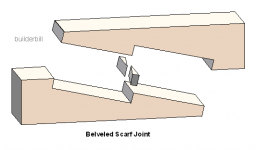John,
I was taught to do 45 degree cuts, glue the joint, and most importantly put the joint over a stud when you nail it. I can honestly say I doubt I've had to do this more than 5-10 times in my entire life of about 1/2 a century. It worked and the joint was close to invisible when compared to a butt joint.
That being said using a domino would lock the two pieces together nicely and eliminate the need to find a stud, but would make installation harder since scarf joints slide over each other. You still would need to caulk or finish a butt joint more than likely, a scarf you don't. I see no true benefit using them honestly and in materials used on houses these days, a domino may be too thick!! [scared]
CB


